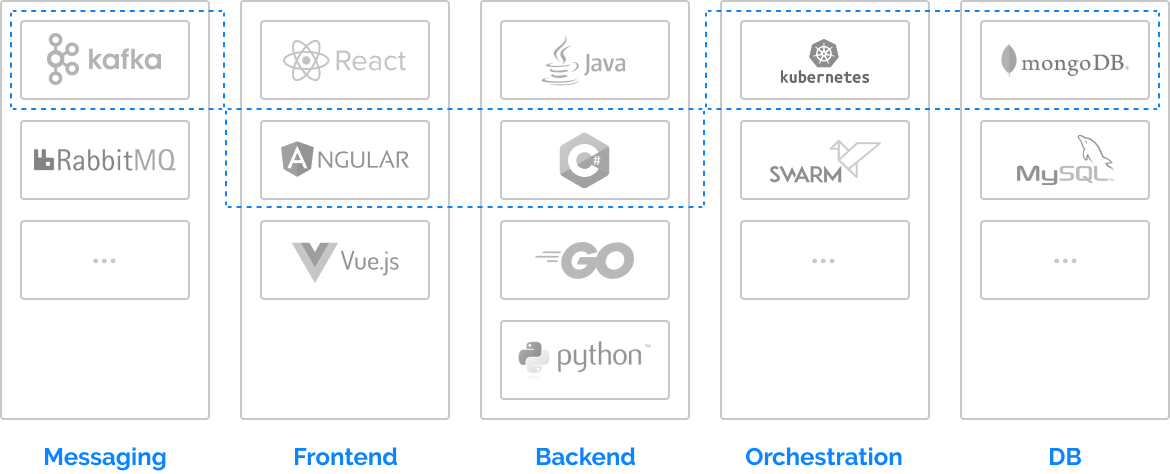Decoupling
into the Microservice Architecture
Our teams will successfully migrate your system or monolithic applications into a microservice architecture with minimum system downtime.
Our teams will successfully migrate your system or monolithic applications into a microservice architecture with minimum system downtime.
There are several major steps in every decoupling project to get the most efficient microservices architecture:
We use different models when migrating to microservices, depending on the specifics of the project.
Please, do not hesitate to contact us if you have any questions regarding your vision of the microservice architecture.
Service Team (Micro-team) – group of engineers who already worked together and know how to do certain task/project.Service Team (Micro-team) – group of engineers who already worked together and know how to do certain task/project.
Ky-ky, я дропдаун
Ky-ky, я дропдаун
Ky-ky, я дропдаун
Our teams use the following criteria to define the first blocks for decoupling into the microservice architecture:
Then we start decoupling other services: approve a set of functional services, draw a services dependency graph and prepare a decoupling plan. We prioritize individual services by business value and external dependencies and split the leaf services first.
Intermediate state (after decoupling of 1-2 services)
The same microservice architecture with the communication layer
If the existing code fits for the purposes of the microservices, we reuse it to the fullest extent possible. In this case, you save some dollars on development and testing.
No need for individual staffing. We have already assembled and balanced engineering teams ready for onboarding and focused on microservice-based projects with good experience in monolithic application decoupling.
Service Team (Micro-team) – group of engineers who already worked together and know how to do certain task/project.Service Team (Micro-team) – group of engineers who already worked together and know how to do certain task/project.
Ky-ky, я дропдаун
Ky-ky, я дропдаун
Ky-ky, я дропдаун
Decoupling projects usually require quite a typical team structure (however, some variations may occur from project to project).
The team may include both back-end and front-end developers and in some cases full-stack developers. And for bigger projects, we create project teams based on a set of service teams thus making the whole staffing process easily scalable.
We may send you a couple of available team profiles within 3 business hours from your request time.
Decoupling is impossible without starting an infrastructure project. Basically, microservices need a special environment to run properly and to provide all related benefits when deployed independently. You should give a think to and establish:
Our team can do the infrastructural project for you to guarantee seamless migration to microservices.
We have deep experience with a set of related tools & new technologies which we professionally use.
Please note: Our solution architect may define the technology stack after an initial review of the application architecture. Check here our reference architecture for decoupling projects.
Amazon Web Services (AWS), Microsoft Azure, Google Cloud Platform (GCP)
Azure DevOps, AWS DevOps Tools (CodeBuild, CodeDeploy, CodePipeline), Google Cloud Build (GCP)
Terraform, Ansible, Helm, AWS CloudFormation, Azure BICEP
GitHub Pipelines, GitLab CI/CD, ArgoCD, Jenkins, Bamboo, GitHub Actions
Prometheus/Grafana, Zabbix, Octopus
Docker, Kubernetes
Apache Kafka, Rabbit MQ, Active MQ, MS SQL SSBS
Qulix offers you to follow our well-tested practices in building the best microservice architecture for your project. See our reference architecture to find what technologies we use for the best results.

The following high-level architecture is used for a typical single microservice.
No worry in case you do not have the listed information. Our software architects will be able to define how to deal with it.
Of course, there are certain difficulties and issues we need to deal with when working with the microservice architecture. Contact us and we will send you the list of our technical best practices regarding microservice architecture implementation.
Feel free to get in touch with us! Use this contact form for an ASAP response.
Call us at +44 151 528 8015
E-mail us at request@qulix.com